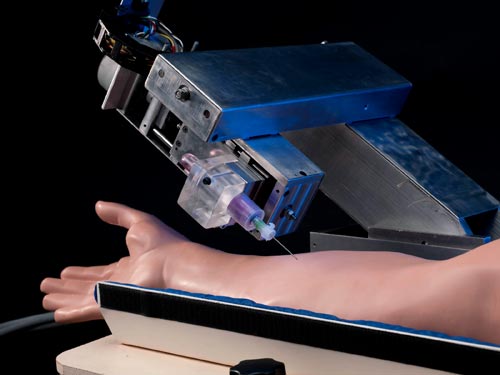plastic board/plate extrusion machine line plastic board/plate extrusion machine line, WPC Skinning Foam Sheet Board Extrusion Machine, China plastic board/plate extrusion machine line KERKE Extrusion Equipment Co.Ltd. , http://www.kerkeextrusion.com On February 17, 2012, Hyundai Heavy Industries officially announced its next-generation medical robot R&D program, representing Hyundai Heavy Industries' official entry into the era of comprehensive R&D of medical robots. Will the medical industry popularize robots in the future? Why does modern heavy industry attach importance to the medical industry? Once this news was disclosed, it immediately raised an important discussion in the industry about how attractive the medical market is. In the machine tool industry, companies are also rushing to the medical industry as the focus of the future development of the industry.
On February 17, 2012, Hyundai Heavy Industries officially announced its next-generation medical robot R&D program, representing Hyundai Heavy Industries' official entry into the era of comprehensive R&D of medical robots. Will the medical industry popularize robots in the future? Why does modern heavy industry attach importance to the medical industry? Once this news was disclosed, it immediately raised an important discussion in the industry about how attractive the medical market is. In the machine tool industry, companies are also rushing to the medical industry as the focus of the future development of the industry.
How big is the medical device market? In a medical device industry development forum, Liu Diankui, deputy director of the Ministry of Health Planning Finance Department, said that the reform of the medical and health system has provided unprecedented opportunities and broad space for development for the domestic medical device industry.
At present, China's "medical reform plan" has been implemented for many years, and medical systems and units at all levels will rapidly develop toward "pharmaceutical separation and medical care". Hospitals and clinics at all levels will make up for the "15% increase in drug sales." Loss of operating income, increased profits, will compete to purchase a large number of medical equipment.
According to reports, during the period from 2012 to 2015, the central government will consider supporting basic medical institutions to carry out basic equipment allocation, strengthen the pilot capacity building of provincial, county, and county-level CDC centers, build professional public health prevention and treatment institutions, and establish occupational health prevention and treatment institutions. Necessary equipment. The medical equipment market demand will grow at a geometric speed.
China's medical device market is huge. According to Cai Tianzhi, director of the Medical Devices Department of the China Chamber of Commerce for the Import and Export of Medicinal Products, China currently has 1,708 state-owned enterprises involved in the medical device market, 4,875 foreign-funded enterprises, and 18,022 private enterprises. Shanghai, Guangdong, Jiangsu, Beijing, and Zhejiang are the focus of China's medical device trade. The five provinces and cities account for more than 70% of China's medical device trade.
Foreign capital or current market leader Liu Diankui said that during the “Twelfth Five-Year Plan†period, it will use economic means to effectively guide medical institutions to use domestically produced medical devices. However, compared with foreign medical device companies, domestic medical device companies are still in a weak position. At present, medical equipment products with a relatively high share of imports in China are dominated by mid- to high-end products, especially in the fields of cardiac pacemakers and orthopaedic implanted medical devices. Foreign companies occupy major markets.
Similarly, as a key mid-to-high-end equipment for medical device manufacturing, machine tools, the processing of humerus trays, hip joints, knee joints, femoral caps and rods, and general-purpose transplants are also based on foreign investment. .
Switzerland's GF AgieCharmilles demonstrated its strong strength in the processing of medical devices. The availability of the MikronUCP600 VarioRTT 5-axis high-performance boring and milling machining center provides a highly flexible solution for multi-species and small-batch production in the medical industry. The process of multi-face machining in a single setup allows it to meet the processing requirements for a variety of medical devices, including bone plates, femoral condyles, and artificial joints. It has become one of the models with a very high market share in the global medical industry.
Switzerland's Toners launched the Sigma20 machine specifically for the Chinese market. According to Wang Kai, Director of Sales and Marketing of Tonas China, the stability and precision of this machine's machining are very prominent. The structure of the spindle/sub-spindle is completely symmetrical, and the balance of the processing cycle is very good. It is particularly favored by the high-end medical orthopedics department, especially the spine orthopedic screw industry. Its processing efficiency is very high. It can sell about 10 units per year in China.
As we all know, lasers are closely related to the accuracy of surgery. They can complete tasks quickly and reliably, with pulse-to-pulse stability and consistent, repeatable quality. Due to its versatility and special capabilities, lasers are the best production tool for cutting, welding and marking medical technology products. The application of marking, cutting and welding in the field of medical technology has reached the peak of the fast laser. Its flexible, accurate and repeatable features provide an important guarantee for the sustained and healthy development of the medical industry.
Cutting tools play a vital role in the processing of precision medical devices that require particularly stringent specifications. At the 2011 Medical Implantation Intervention Innovation Summit Forum, Sandvik Coromant experts made brilliant presentations on topics such as medical device metalworking tool solutions and Sandvik artificial joints and medical materials. Sandvik Coromant's celebrity cutting tools in the field of metal processing for medical devices include: CoroMill 325-threaded cyclone bodies and inserts for a variety of different sizes of slitting machines, as well as quick-change capabilities combined with high-precision coolant holes QS quick change tool handle system and so on.
The medical industry is the "Taro" of the machine tool market